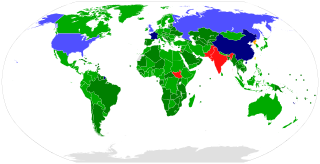
The Treaty on the Non-Proliferation of Nuclear Weapons, commonly known as the Non-Proliferation Treaty or NPT, is an international treaty whose objective is to prevent the spread of nuclear weapons and weapons technology, to promote cooperation in the peaceful uses of nuclear energy, and to further the goal of achieving nuclear disarmament and general and complete disarmament. Between 1965 and 1968, the treaty was negotiated by the Eighteen Nation Committee on Disarmament, a United Nations-sponsored organization based in Geneva, Switzerland.

Nuclear proliferation is the spread of nuclear weapons, fissionable material, and weapons-applicable nuclear technology and information to nations not recognized as "Nuclear Weapon States" by the Treaty on the Non-Proliferation of Nuclear Weapons, commonly known as the Non-Proliferation Treaty or NPT. Proliferation has been opposed by many nations with and without nuclear weapons, as governments fear that more countries with nuclear weapons will increase the possibility of nuclear warfare, de-stabilize international or regional relations, or infringe upon the national sovereignty of nation states.
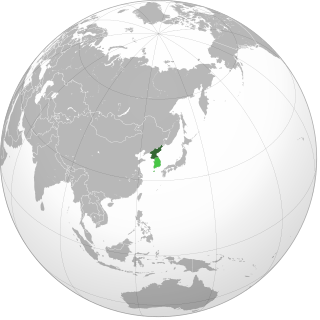
North Korea has a military nuclear weapons program and, as of early 2020, is estimated to have an arsenal of approximately 30 to 40 nuclear weapons and sufficient production of fissile material for six to seven nuclear weapons per year. North Korea has also stockpiled a significant quantity of chemical and biological weapons. In 2003, North Korea withdrew from the Treaty on the Non-Proliferation of Nuclear Weapons (NPT). Since 2006, the country has conducted six nuclear tests at increasing levels of expertise, prompting the imposition of sanctions.

The Nyongbyon Nuclear Scientific Research Center (녕변원자력연구소) is North Korea's major nuclear facility, operating its first nuclear reactors. It is located in Nyongbyon County in North Pyongan Province, about 100 km north of Pyongyang. The center produced the fissile material for North Korea's six nuclear weapon tests from 2006 to 2017, and since 2009 is developing indigenous light water reactor nuclear power station technology.

The People's Republic of China has developed and possesses weapons of mass destruction, including chemical and nuclear weapons. The first of China's nuclear weapons tests took place in 1964, and its first hydrogen bomb test occurred in 1967 at Lop Nur. Tests continued until 1996, when the country signed the Comprehensive Nuclear-Test-Ban Treaty (CTBT), but did not ratify it. China acceded to the Biological Weapons Convention (BWC) in 1984 and ratified the Chemical Weapons Convention (CWC) in 1997.
Iran has several research sites, two uranium mines, a research reactor, and uranium processing facilities that include three known uranium enrichment plants.

Taiwan pursued a number of weapons of mass destruction programs from 1949 to the late 1980s. The final secret nuclear weapons program was shut down in the late 1980s under US pressure after completing all stages of weapons development besides final assembly and testing; they lacked an effective delivery mechanism and would have needed to further miniaturize any weapon before it could be effectively used in combat. Currently, there is no evidence of Taiwan possessing any chemical, biological, or nuclear weapons. However, nuclear weapons from the United States were deployed to Taiwan during a period of heightened regional tensions with China beginning with the First Taiwan Strait Crisis and ending in the 1970s.
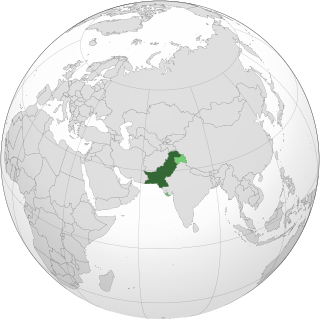
Pakistan is one of nine states that possess nuclear weapons. Pakistan began developing nuclear weapons in January 1972 under Prime Minister Zulfikar Ali Bhutto, who delegated the program to the Chairman of the Pakistan Atomic Energy Commission (PAEC) Munir Ahmad Khan with a commitment to having the device ready by the end of 1976. Since PAEC, which consisted of over twenty laboratories and projects under reactor physicist Munir Ahmad Khan, was falling behind schedule and having considerable difficulty producing fissile material, Abdul Qadeer Khan, a metallurgist working on centrifuge enrichment for Urenco, joined the program at the behest of the Bhutto administration by the end of 1974. Producing fissile material was pivotal to the Kahuta Project's success and thus to Pakistan obtaining the capability to detonate a nuclear weapon by the end of 1984.

Iran is not known to currently possess weapons of mass destruction (WMD) and has signed treaties repudiating the possession of WMDs including the Biological Weapons Convention, the Chemical Weapons Convention, and the Non-Proliferation Treaty (NPT). Iran has first-hand knowledge of WMD effects—over 100,000 Iranian troops and civilians were victims of chemical weapons during the 1980s Iran–Iraq War.

Hyunmoo is a series of strategic missiles developed by South Korea.

The Hyunmoo-3 is a cruise missile fielded by the South Korean military designed by Agency for Defense Development (ADD). The name Hyunmoo comes from a mythical beast described as the "Guardian of the Northern Sky", perhaps hinting North Korea.

This chronology of the North Korean nuclear program has its roots in the 1950s and begins in earnest in 1989 with the end of the Cold War and the collapse of the Soviet Union, the main economic ally of North Korea. The chronology mainly addresses the conflict between the United States and North Korea, while including the influences of the other members of the six-party talks: China, Russia, South Korea, and Japan.

Romania started pursuing nuclear technology, according to some scholars, as early as 1967. In the 1980s, during the long rule of Nicolae Ceaușescu, Romania had a secret program intended to develop nuclear weapons, violating its word on the Treaty on the Non-Proliferation of Nuclear Weapons of 1970. The program ended after the Romanian Revolution of 1989. Romania is considered free of weapons of mass destruction, using nuclear power only for civilian purposes.
President Adly Mansour announced on 7 November 2013 that Egypt was restarting its nuclear power program in El Dabaa; a deal was reached with the residents in which it was agreed that a residential area will also be built. The Egyptian minister of electricity, Ahmed Emam, has called the project "necessary" because of a small amount of renewable energy sources and not enough fuel.
This timeline of nuclear weapons development is a chronological catalog of the evolution of nuclear weapons rooting from the development of the science surrounding nuclear fission and nuclear fusion. In addition to the scientific advancements, this timeline also includes several political events relating to the development of nuclear weapons. The availability of intelligence on recent advancements in nuclear weapons of several major countries is limited because of the classification of technical knowledge of nuclear weapons development.
Nuclear latency or a nuclear threshold state is the condition of a country possessing the technology to quickly build nuclear weapons, without having actually yet done so. Because such latent capability is not prescribed by the Nuclear Non-Proliferation Treaty, this is sometimes called the "Japan Option", as Japan is considered a "paranuclear" state, being a clear case of a country with complete technical prowess to develop a nuclear weapon quickly, or as it is sometimes called "being one screwdriver's turn" from the bomb, as Japan is considered to have the materials, expertise and technical capacity to make a nuclear bomb at will. However, nuclear latency does not presume any particular intentions on the part of a state recognized as being nuclear-latent.
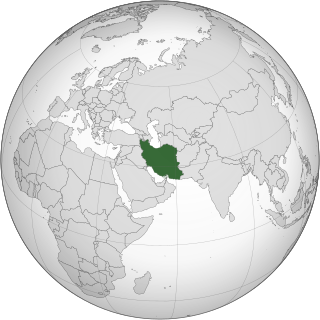
United Nations Security Council Resolution 1929, adopted on 9 June 2010, after recalling resolutions 1696 (2006), 1737 (2006), 1747 (2007), 1803 (2008), 1835 (2008) and 1887 (2009) concerning the topics of Iran and non-proliferation, the Council noted that Iran had failed to comply with previous Security Council resolutions concerning its nuclear program and imposed further sanctions on the country.
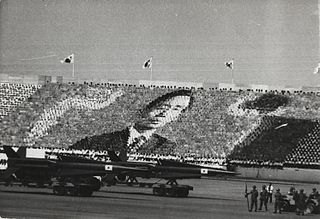
In 1979, South Korea agreed to ballistic missile guidelines, limiting the country's ballistic missile development and possession to 180 km in range.

Saudi Arabia has not officially maintained and possessed weapons of mass destruction (WMD). In 1972 Saudi Arabia signed and approved the convention on the prohibition of the development, production and stockpiling of biological (bacteriological) and toxin weapons. Nevertheless, Saudi Arabia has made steps towards a nuclear program and according to some observations, they can be used to develop nuclear weapons. According to some reports, Riyadh has an alleged deal with Pakistan regarding nuclear weapons projects.













